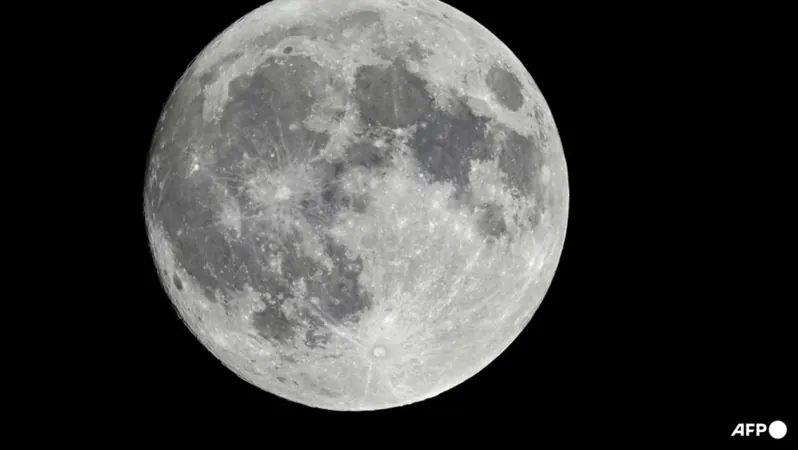
China Embarks on Groundbreaking Lunar Base Experiment: Could Moon Soil Build Our Future?
2024-11-15
Author: Wei Ling
Introduction
In a bold stride towards establishing a permanent human presence on the Moon, China is set to launch an experimental mission on November 15, aimed at assessing the feasibility of constructing lunar bricks using materials sourced directly from the Moon’s surface. This innovative experiment marks a significant milestone in China's ambitious plans to build its first lunar base by 2035, with aspirations to land humans on the Moon by 2030.
Mission Overview
The mission will see samples of prototype bricks, designed to simulate the properties of lunar soil, sent aboard a cargo rocket destined for the Tiangong space station. The process of sending building materials from Earth has proven to be both costly and logistically challenging—thus, utilizing lunar soil is seen as a potential game-changer.
Research Development
A team of researchers from Huazhong University of Science and Technology in Wuhan has developed these prototype bricks from various earth-sourced materials, such as basalt, which closely resemble the composition and characteristics of lunar regolith—the loose soil covering the Moon’s surface. Once the samples arrive at the Tiangong space station, they will be subjected to rigorous testing over a three-year period to evaluate their performance under harsh lunar conditions.
Objectives and Challenges
According to Professor Zhou Cheng, who is leading the research team, the primary objective is to observe how the bricks withstand the extreme environmental factors that prevail on the Moon. The temperature fluctuations can range dramatically between 180 degrees Celsius during the day and plunge to -190 degrees Celsius at night, coupled with exposure to intense cosmic radiation and the potential for moonquakes.
Research Findings
"We will place our material in space and allow it to experience the lunar environment. Our observations will help determine if its durability remains intact despite these extreme conditions," Zhou elaborated.
Strength and Design
The creation of these lunar bricks is not without progress. The team's research is inspired by the findings from China's Chang'e-5 mission, which brought back lunar soil samples for study—the first such endeavor in 40 years. Zhou claims that the developed bricks are three times stronger than traditional terrestrial bricks and possess interlocking features that eliminate the need for additional binding agents.
Innovative Technologies
Furthermore, the team is advancing the concept of a "Lunar Spider," a specialized 3D printing robot designed to construct structures on the Moon utilizing lunar materials directly.
Expert Opinions
Experts are optimistic about the implications of this research. Jacco van Loon, an astrophysicist from Keele University in the UK, spoke to AFP regarding the project. "Using lunar resources to build structures on the Moon is not only practical but significantly more economical. The likelihood of success is high, and these experiments could potentially lay the groundwork for future lunar bases."
International Collaboration
China’s Lunar developments do not occur in isolation. The country is collaborating with Russia on the International Lunar Research Station (ILRS), with support from a coalition of over a dozen countries including Thailand, Pakistan, and Venezuela. Meanwhile, the United States is also gearing up for a lunar return, seeking to establish its outpost under NASA's Artemis program, aiming for human landings by 2026 despite facing some delays.
Conclusion
Additionally, the European Space Agency is exploring possibilities as well, with studies investigating the use of building materials inspired by Lego’s structural integrity.
As we stand on the brink of a new era of lunar exploration, the question remains: Will lunar soil truly become the building block of our future extraterrestrial homes? The upcoming experiments could very well provide the answer, ushering us towards a new chapter in humanity's journey in space.




 Brasil (PT)
Brasil (PT)
 Canada (EN)
Canada (EN)
 Chile (ES)
Chile (ES)
 España (ES)
España (ES)
 France (FR)
France (FR)
 Hong Kong (EN)
Hong Kong (EN)
 Italia (IT)
Italia (IT)
 日本 (JA)
日本 (JA)
 Magyarország (HU)
Magyarország (HU)
 Norge (NO)
Norge (NO)
 Polska (PL)
Polska (PL)
 Schweiz (DE)
Schweiz (DE)
 Singapore (EN)
Singapore (EN)
 Sverige (SV)
Sverige (SV)
 Suomi (FI)
Suomi (FI)
 Türkiye (TR)
Türkiye (TR)